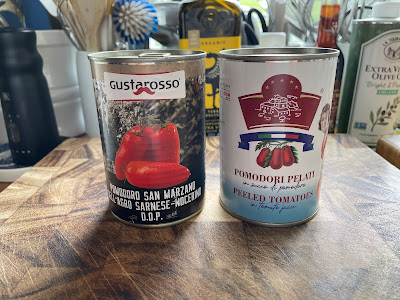Adapted from The Kitchen Diaries by Nigel Slater (Fourth Estate, 2005)
Sauces 8 ounces of pasta generously
I’ve been making Marcella Hazan’s iconic Bolognese sauce for years, and I believe it’s the real thing. I’ve even used it to stuff inside my grandmother’s crespelle, turning them into cannelloni. But as delicious as it is, it isn’t very saucy—and sometimes I want something with a bit more sauce and umami depth. That’s what I found in The Kitchen Diaries by Nigel Slater.
I’ve been led to believe no self-respecting Italian would even think about serving Bolognese over spaghetti. But English people do, Nigel Slater does, and now sometimes so do I. That said, this sauce is especially good on rigatoni, mezzi rigatoni—or my favorite, shells, such as Faella Tofe—because it snuggles inside the crevices.
Please try to find canned tomatoes from Italy and Italian pasta cut with bronze dies and slow-dried, like Pasta Setaro or Faella. The difference is noticeable. The pasta is rough, not smooth, and sauces don't slip off. Excellent online sources for these are BuonItalia (tomatoes and Pasta Setaro) and Gustiamo (tomatoes and Faella pasta).
I often serve this on a plate with a vegetable instead of a salad. And I highly recommend opening a particularly delicious bottle of red wine to use in the sauce and drink with dinner.
Because I want this to be saucy, I’ve increased the amount of tomatoes from 1 cup to a full 400g can (check the weight on the label—that's still the small can), and decreased the meat from 1 pound to ½ pound.
4 tablespoons butter
About 3 ounces pancetta, cut in 1/4-inch cubes
1 small to medium onion, chopped
2 plump garlic cloves, coarsely chopped
1 carrot, peeled and chopped
2 stalks celery, peeled and chopped
4 ounces cremini mushrooms, chopped the same size as the onions, carrot, and celery
1 bay leaf (I use Morton & Bassett)
½ pound ground beef – the best you can get
1 400g can Italian whole peeled tomatoes, crushed by hand
¼ cup red wine (good enough to drink with dinner)
¾ cup stock (I use Better Than Bouillon Vegetable Base)
Freshly grated nutmeg – a little
Salt and pepper, to taste
¼ cup heavy cream (use a light hand)
Freshly grated Parmesan, to taste
Don’t leave out the bay leaf or the nutmeg—they both add a lot to the sauce. And remember to be parsimonious with the cream; you don’t want the sauce to be creamy.
Melt the butter, then cook the pancetta without letting it color—3 to 5 minutes—to render some of the fat. Stir in the onion and garlic, then the carrot and celery, then the mushrooms. Cook over medium heat, stirring often.
Turn up the heat a little and add the ground beef, breaking it up. Cook for about 3 minutes without stirring so the meat starts to brown. Stir again. Add the tomatoes, wine, stock, bay leaf, nutmeg, and a little salt and pepper.
Reduce the heat until the sauce is just gently moving. Partially cover the pan and cook for about an hour, stirring occasionally and checking to make sure it doesn’t dry out.
Pour in the heavy cream slowly, using a light hand. Stir and cook for another 15 to 20 minutes, keeping in mind that you don’t want the sauce to get thick. Taste and adjust seasoning.






